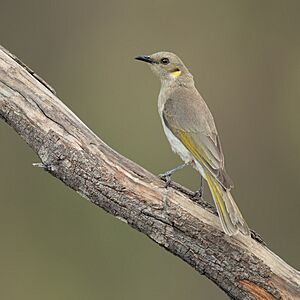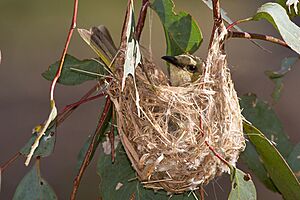Fuscous honeyeater facts for kids
Quick facts for kids Fuscous honeyeater |
|
|---|---|
 |
|
| Conservation status | |
| Scientific classification | |
| Genus: |
Ptilotula
|
| Species: |
fusca
|
| Synonyms | |
|
Lichenostomus fuscus |
|
The fuscous honeyeater (Ptilotula fusca) is a type of bird found only in Australia. It lives in the eastern parts of the country. These birds prefer dry forests and woodlands in warm areas.
Scientists used to place the fuscous honeyeater in a different bird group called Lichenostomus. But in 2011, new studies looked at their DNA. These studies showed that the old group was not quite right. So, the fuscous honeyeater was moved to a new group called Ptilotula.
Contents
What Does It Look Like?
The fuscous honeyeater is a small bird. Its back and top parts are a dull grey-brown or olive-brown color. Its belly and underside are a lighter buffy-grey.
It has a black beak and dark rings around its eyes. A special feature is a small black and yellow feather patch. This patch is located right behind its ear. Other birds, like the grey-fronted honeyeater, look similar.
What Sounds Does It Make?
Fuscous honeyeaters are quite chatty birds! They have many different calls. One special call sounds like arig arig a taw taw. They also make a clear, flute-like sound, cheer tor cheer. You might also hear an endless chip sound. This "chip" call helps them stay in touch with each other.
Where Do They Live and What Do They Do?
Fuscous honeyeaters often live together in groups. They like dry eucalypt forests and woodlands. Most of them live inland, away from the coast. However, in New South Wales and Queensland, they can also be found near the coast. Sometimes, you can even spot them in gardens! They also live in small forest patches on farms.
These birds usually stay in one place. But they might move around if there is a drought. They also move to find flowering eucalypt trees. In cooler areas, they might move to lower places during winter. This helps them find warmer spots and more food.
What Do They Eat?
Fuscous honeyeaters mostly eat insects. They actively search for bugs in trees. They look on leaves, branches, and tree trunks. They are also good at catching insects while flying.
Besides insects, they also eat other things. They drink nectar from flowers, especially from eucalypts. They also enjoy sweet substances like lerp and honeydew. These are sugary liquids found on plants.
Is It Safe?
The fuscous honeyeater is listed as a species of Least Concern. This means that their numbers are stable. They are not currently in danger of disappearing. The IUCN Red List of Threatened Species keeps track of this information.



